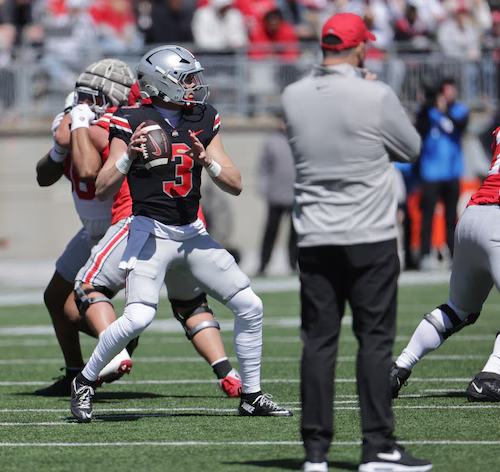As college football continues to evolve, so too does roster management, with the NCAA’s transfer portal now playing a central role in how programs fill gaps, bolster depth, and stay competitive. For Ohio State, a perennial title contender, the spring transfer portal window offers a crucial opportunity to fine-tune its roster ahead of the 2025 season. With spring practices offering a first glimpse at positional strengths and weaknesses, all eyes are on head coach Ryan Day and his staff to see whether the Buckeyes will be active shoppers or cautious evaluators during this final window of roster movement before the fall.
Ohio State enters the spring window in a position of relative strength, having assembled one of the most talented rosters in the country through traditional recruiting and strategic transfer additions over the past year. However, even elite programs must confront the reality of roster turnover, whether through early NFL declarations, the natural cycle of graduation, or the rising tide of player movement enabled by the portal. What sets Ohio State apart is its ability to adapt quickly and aggressively when needed, especially when a national championship is the expectation rather than the aspiration.
One of the biggest question marks following spring practices is the defensive line. Though Ohio State boasts a strong tradition in the trenches and has recruited well at the position, the departures of key contributors have left the unit thinner than in recent years. While the Buckeyes still have potential breakout stars and young talent, the need for experienced, plug-and-play linemen could drive Day and defensive line coach Larry Johnson to explore available portal options. A veteran edge rusher or an interior presence with Power Five experience could help solidify a unit that plays a critical role in the team’s defensive scheme.
Another area worth watching is the offensive line, which has quietly undergone changes over the past two seasons. While last year’s group showed flashes of dominance, there were also moments of inconsistency, especially in pass protection against elite opponents. Spring camp has provided a stage for young linemen to compete for starting jobs, but if the coaching staff determines that the current group isn’t ready for championship-level play, it wouldn’t be a surprise to see a move made. Finding a seasoned tackle or interior lineman with starting experience could ease pressure on the younger players and provide more stability for the offense as a whole.
At the skill positions, the Buckeyes are loaded — but even abundance requires careful management. With one of the most talented wide receiver rooms in the country and a stable of running backs that can rotate without drop-off, it’s unlikely that Ohio State would pursue major additions at these spots. However, the transfer portal isn’t just about adding stars; it’s also about maintaining balance. If any unexpected departures occur, particularly among depth players seeking more playing time elsewhere, the staff may need to respond accordingly to avoid being caught short during the season.
The quarterback position, as always, commands attention. Following the departure of previous starters and the rise of a new face under center, the Buckeyes have reason to feel confident about their QB room. However, that confidence doesn’t mean the situation is immune to change. Quarterback rooms across the country are notoriously volatile in the portal era, with top-tier talent often unwilling to wait two or three years for a starting opportunity. If a backup or third-string player were to leave in search of a clearer path to playing time, it might prompt Ohio State to consider bringing in a veteran signal-caller as insurance, especially if they aren’t completely confident in the developmental readiness of the younger quarterbacks behind the starter.
Defensively, the secondary appears to be in solid shape, but like the defensive line, it’s a position that could use an infusion of depth. Injuries and attrition are inevitable over the course of a season, and having another versatile defensive back who can cover both in the slot and on the perimeter would offer valuable insurance. Furthermore, with today’s high-octane offenses attacking defenses from multiple angles, having a deep and adaptable secondary is essential for any team with playoff ambitions.
One underrated aspect of spring transfer strategy is special teams. It’s not flashy, but it matters. If Ohio State were to lose a kicker, punter, or long snapper unexpectedly, the portal would be the most viable way to replace that piece quickly. Likewise, a return specialist with game-breaking ability could be a luxury addition if the staff feels the current roster lacks someone who can consistently flip the field or provide scoring opportunities in the return game.
Beyond the roster itself, the human side of these decisions can’t be overlooked. Spring practices give players their first real sense of where they stand on the depth chart. Those who expected to compete for starting jobs may find themselves buried, while late risers may earn the trust of coaches. For those on the outside looking in, the transfer portal provides a fresh start. For coaches, it provides a challenge — managing morale while fielding calls, both inbound and outbound, that could alter the chemistry of the team.
Ohio State, like most elite programs, is in a unique position. It doesn’t need to overhaul its roster in the spring, but it does need to remain vigilant. The staff has built a culture where players compete fiercely but also buy into the program’s long-term vision. Still, when opportunity knocks — either through a surprise portal entry or a sudden need — the Buckeyes have shown they’re willing to act. Last year’s portal class proved the staff’s ability to identify immediate contributors, and there’s no reason to think that formula will change now.
Another layer to consider is the NIL landscape. As collectives and boosters continue to shape transfer movement behind the scenes, programs that have well-organized NIL strategies are at a clear advantage. Ohio State has remained competitive in this space, offering legitimate opportunities for athletes to build their brand while competing for championships. This can be a powerful selling point when recruiting top talent out of the portal. It also helps in retention, keeping key players from being lured away by other programs promising more lucrative deals.
The spring transfer portal window, while shorter than its winter counterpart, can have outsized importance for teams on the cusp of greatness. For Ohio State, which has legitimate championship aspirations and a coaching staff that knows what it takes to get there, this window may not bring a flurry of moves — but it could bring a few critical ones. Whether it’s a depth piece that proves invaluable in October or a starter who shores up a position of concern, the moves made (or not made) over these few weeks can ripple through the entire season.
In sum, yes — it is likely that Ohio State football will make at least a few roster moves in the spring transfer portal window. They may not be dramatic or headline-grabbing, but they will be strategic. The Buckeyes don’t need to chase talent for the sake of headlines. They need to find the right pieces to complete a puzzle already built for success. If the past few years have taught us anything, it’s that winning at the highest level requires both talent and timing. The spring portal offers a chance to get both right. And if there’s one program that understands how to maximize opportunity, it’s Ohio State.



